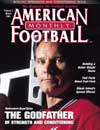AMERICAN FOOTBALL MONTHLY THE #1 RESOURCE FOR FOOTBALL COACHES
Article CategoriesAFM Magazine
|
Big Man On CampusIf a scrawny pole vaulter had never picked up a barbell, football might be a different sport today.by: Jane Musgrave © More from this issue When Boyd Eply told Nebraska head coach Bob Devaney he was going to teach his Cornhuskers how to lift weights, Devaney was about as excited as if Eply had told him he was going to teach them how to fumble in the end zone. "Why would you want to do that?" Devaney asked. "I have a friend at Michigan State and he doesn't lift weights. I have a friend at Ohio State and he doesn't lift weights. In fact, I don't know anyone in the whole country who lifts weights. The way I understand it, it could hurt players." Eply, then a struggling undergraduate student, calmly explained that lifting weights would make Devaney's players stronger and faster. While the legendary coach didn't actually harrumph, he wasn't impressed either. "OK," Devaney grudgingly agreed. "But if anyone gets slower, you're going to get fired." Thr....The full article can only be seen by subscribers.
|
|
|||||||
| HOME |
MAGAZINE |
SUBSCRIBE | ONLINE COLUMNISTS | COACHING VIDEOS |
Copyright 2025, AmericanFootballMonthly.com
All Rights Reserved





